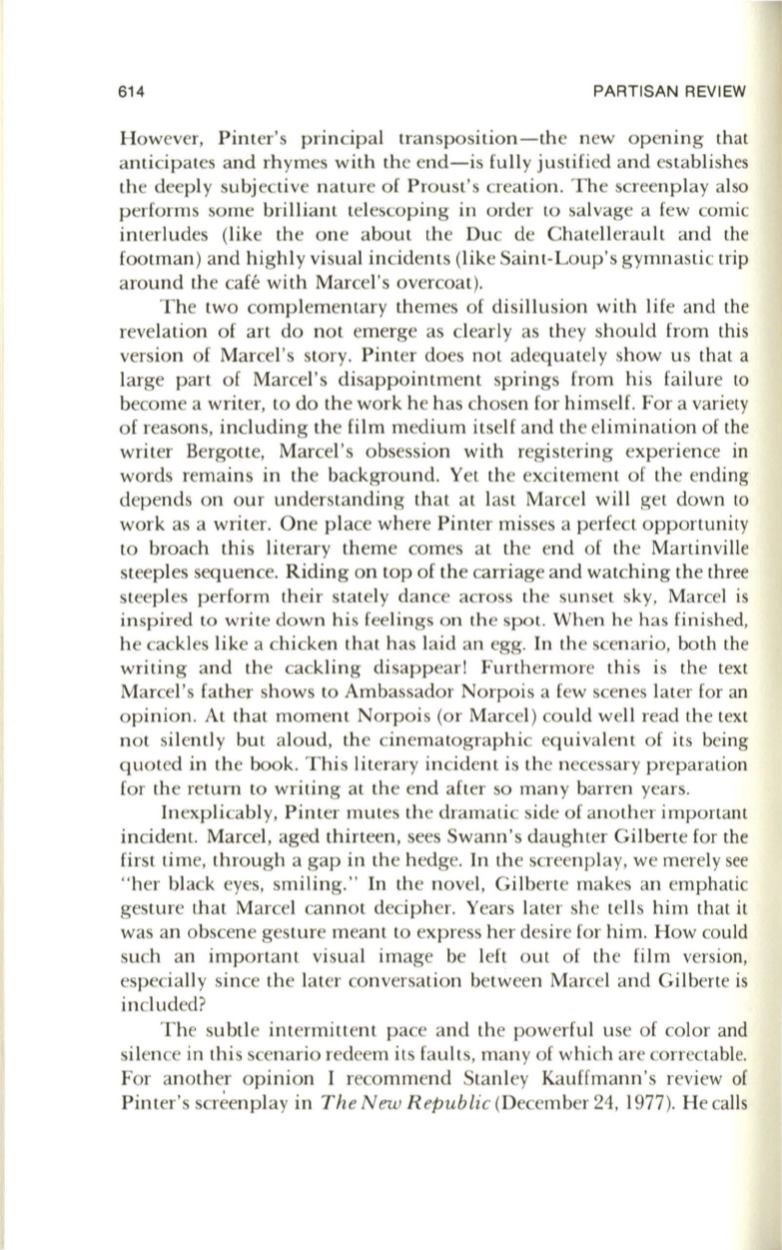
614
PARTISAN REVIEW
However, Pinter's principal transposition-the new opening that
anticipates and rhymes with the end-is fully justified and establishes
the deeply subjective nature of Proust's creation. The screenplay also
performs some brilliant telescoping in order to salvage a few comic
interludes (like the one about the Duc de Chatellerault and the
footman) and highly visual incidents (like Saint-Loup's gymnastic trip
around the cafe with Marcel's overcoat).
The two complementary themes of disillusion with life and the
revelation of art do not emerge as clearly as they should from this
version of Marcel's story. Pinter does not adequately show us that a
large part of Marcel's disappointment springs from his failure
to
become a writer, to do the work he has chosen for himself. For a variety
of reasons, including the film medium itself and the elimination of the
writer Bergotte, Marcel's obsession with registering experience in
words remains in the background. Yet the excitement of the ending
depends on our understanding that at last Marcel will get down
to
work as a writer. One place where Pinter misses a perfect opportunity
to broach this literary theme comes at the end of the Martinville
steeples sequence. Riding on top of the carriage and watching the three
steeples perform their stately dance across the sunset sky, Marcel is
inspired to write down his feelings on the spot. When he has finished,
he cackles like a chicken that has laid an egg. In the scenario, both the
writing and the cackling disappear! Furthermore this is the text
Marcel's father shows to Ambassador Norpois a few scenes later for an
opinion. At that moment Norpois (or Marcel) could well read the text
not silently but aloud, the cinematographic equivalent of its being
quoted in the book. This literary incident is the necessary preparation
for the return
to
writing at the end after so many barren years.
Inexplicably, Pinter mutes the dramatic side of another important
incident. Marcel, aged thirteen, sees Swann's daughter Gilberte for the
first time, through a gap in the hedge. In the screenplay, we merely see
"her black eyes, smiling." In the novel, Gilberte makes an emphatic
gesture that Marcel cannot decipher. Years later she tells him that it
was an obscene gesture meant to express her desire for him. How could
such an important visual image be left out of the film version,
especially since the later conversation between Marcel and Gilberte is
included?
The subtle intermittent pace and the powerful use of color and
silence in this scenario redeem its faults, many of which are correctable.
For another opinion I recommend Stanley Kauffmann's review of
Pinter's screenplay in
The New Republic
(December 24, 1977). He calls


